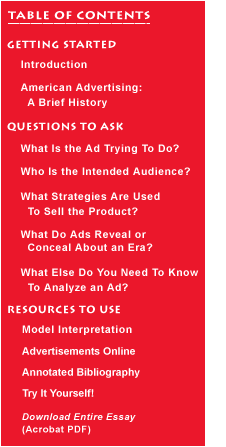talking history | syllabi | students | teachers | puzzle | about us

|
 |
In examining ads as historical documents, we also should look at what the ad seems to take for granted. Inferring social conditions from advertisements is not straightforward. Ads are highly selective in their depiction of the world. Notably, historical and contemporary studies abound showing that advertising’s depiction of American society has been highly skewed in its portrayal of race, class, and gender. Until a generation ago, African Americans and other people of color were virtually invisible in mainstream advertising, except when they were portrayed as servants or as exemplifying racially stereotyped behavior. Note, for example, the frequent portrayal of African Americans as children, or, tellingly, as childlike adults. (See some examples at a University of Illinois exhibit and the Authentic History Center and follow the successive pages.) Images of women in advertising have hardly been uniform, but several themes recur: the housewife ecstatic over a new cleaning product; the anxious woman fearing the loss of youthful attractiveness; the subservient spouse dependent on her assertive husband; the object of men’s sexual gaze and desire. (Click here for a 1951 cosmetics ad featuring one of these themes.) Advertising also gives false testimony about the actual class structure of American society. Advertising images consistently show scenes of prosperity, material comfort, even luxury well beyond the conditions of life of most Americans. The advertising industry prefers to picture the world that consumers aspire to, not the one they actually inhabit. David Ogilvy, one of the icons of mid-century American advertising, perhaps knew better than anyone how to use snob appeal for mass audiences. His campaigns for Hathaway Shirts, for example, presented a sophisticated White Russian aristocrat mysteriously wearing a patch over one eye. For Schweppes Tonic Water, Ogilvy not only coined the term “Schweppervescence,” but linked the product to a dignified British naval officer, Commander Whitehead, who extolled the mixer at elegant soirees and descended from jets onto a red carpet to associate the beverage with the heights of cosmopolitan sophistication. Even in the striving, materialistic climate of the post-World War II boom, consumers no doubt saw the Ogilvy campaigns as something other than hard-nosed realism. Middle-class Americans would not see a shirt or a soda brand as their ticket to high society. The advertisements were not dishonest in any direct sense. But David Ogilvy’s ads presented a distorted image of society and did so in the service of selling his clients’ products. Advertising, in Michael Schudson’s phrase, is “capitalist realism,” an art form that abstracts from and reconfigures the world as it is to fit the marketing needs of the business system. He concludes, “Advertising is capitalism’s way of saying ‘I love you’ to itself.”*
|
|

|
|

